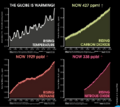Category:Soil
https://en.wikipedia.org/wiki/Soil_biology
Soil biology is the study of microbial and faunal activity and ecology in soil. Soil life, soil biota, soil fauna, or edaphon is a collective term that encompasses all the organisms that spend a significant portion of their life cycle within a soil profile, or at the soil-litter interface. These organisms include earthworms, nematodes, protozoa, fungi, bacteria and different arthropods. Soil biology plays a vital role in determining many soil characteristics. The decomposition of organic matter by soil organisms has an immense influence on soil fertility, plant growth, soil structure, and carbon storage. As a relatively new science, much remains unknown about soil biology and their effects on soil ecosystems.
The soil is home to a large proportion of the world's biodiversity. The links between soil organisms and soil functions are observed to be incredibly complex. The interconnectedness and complexity of this soil ‘food web’ means any appraisal of soil function must necessarily take into account interactions with the living communities that exist within the soil. We know that soil organisms break down organic matter, making nutrients available for uptake by plants and other organisms. The nutrients stored in the bodies of soil organisms prevent nutrient loss by leaching. Microbial exudates act to maintain soil structure, and earthworms are important in bioturbation. However, we find that we don't understand critical aspects about how these populations function and interact. The discovery of glomalin in 1995 indicates that we lack the knowledge to correctly answer some of the most basic questions about the biogeochemical cycle in soils. We have much work ahead to gain a better understanding of how soil biological components affect us and the biosphere...
○ ○ ○ ○ ○ ○ ○ ○ ○ ○ ○ ○ ○ ○ ○ ○ ○ ○ ○ ○ ○ ○
○ ○ ○ ○ ○ ○ ○ ○ ○ ○ ○ ○ ○ ○ ○ ○
Nature Communications:
Article number: 8862 / Published: 23 November 2015
The belowground compartment of ecosystems harbours a tremendous amount of global biodiversity.
Extinction models for belowground organisms are currently unavailable; thus, soil ecologists at the moment have no choice but to generalize the predictions for aboveground biota to their system. Yet, the ecology of belowground biota differs considerably from that of the aboveground organisms that have so far been considered in extinction models — at least with regard to their niche structure which we consider in the following. The most conspicuous difference relates to body size variability which, even without considering belowground microbes, is several orders of magnitude larger in soils. Unlike their aboveground relatives, microbial organisms in soil also represent the base trophic level of their food webs and are responsible for overall ecosystem functioning....
Habitat loss and global change
The extinction ecology for the majority of belowground organisms is thus likely to be quite different from that of the macroorganisms that have been considered so far in the literature. To gain informative insights on extinction susceptibility it is important to first compare the drivers of prospective extinctions belowground with those that have been studied so far in extinction ecology... documented drivers of extinctions are habitat loss and fragmentation.
[S]oil biota play a large role in sustainable ecosystem management.... [We need to] communicate the importance of belowground biota for ecosystem-services sustainability to aboveground extinction ecologists.
○
○
○ ○ ○ ○ ○ ○ ○ ○ ○ ○ ○ ○ ○ ○ ○ ○ ○ ○ ○
Soil Science Resources
SoilWeb / US - Google Earth Library
The United States Department of Agriculture Natural Resources Conservation Service has compiled detailed soils data for approximately 95 percent of the counties in the United States. The soils data contains information such as the texture, drainage, depth, and chemical characteristics of the soil. This data can be accessed by reviewing hard copy Soil Surveys (which can typically be found at the local library or local NRCS office), or online from the NRCS Web Soil Survey.
○ ○ ○ ○ ○ ○ ○ ○ ○ ○ ○ ○ ○ ○ ○ ○
The 12 soil orders are listed below in the sequence in which they key out in Soil Taxonomy / see international location mapping for each
- Gelisols - soils with permafrost within 2 m of the surface
- Histosols - organic soils
- Spodosols - acid forest soils with a subsurface accumulation of metal-humus complexes
- Andisols - soils formed in volcanic ash
- Oxisols - intensely weathered soils of tropical and subtropical environments
- Vertisols - clayey soils with high shrink/swell capacity
- Aridisols - CaCO3-containing soils of arid environments with subsurface horizon development
- Ultisols - strongly leached soils with a subsurface zone of clay accumulation and <35% base saturation
- Mollisols - grassland soils with high base status
- Alfisols - moderately leached soils with a subsurface zone of clay accumulation and >35% base saturation
- Inceptisols - soils with weakly developed subsurface horizons
- Entisols - soils with little or no morphological development
○ ○ ○ ○ ○ ○ ○ ○
http://server.arcgisonline.com/ArcGIS/rest/services/Specialty/Soil_Survey_Map/MapServer
http://www.arcgis.com/home/item.html?id=204d94c9b1374de9a21574c9efa31164
○
http://websoilsurvey.nrcs.usda.gov/app/HomePage.htm
Web Soil Survey (WSS) provides soil data and information produced by the National Cooperative Soil Survey. It is operated by the USDA Natural Resources Conservation Service (NRCS) and provides access to the largest natural resource information system in the world. NRCS has soil maps and data available online for more than 95 percent of the nation’s counties and anticipates having 100 percent in the near future. The site is updated and maintained online as the single authoritative source of soil survey information.
http://www.nrcs.usda.gov/wps/portal/nrcs/detail/soils/survey/geo/?cid=nrcs142p2_053619
○
Hydro-overlays
The World Hydro Reference Overlay Map service is designed to be used as a base map by scientists, professionals, and researchers in the fields of Hydrology, Geography, Climate, Soils, and other natural sciences. The map features a hydro-centric design based on the amount of water flowing within the drainage network such that symbols of the same size and color represent roughly the same amount of water.
http://www.arcgis.com/home/item.html?id=f7c73101a09c44058f8f029eefd37bd6
Subcategories
This category has the following 7 subcategories, out of 7 total.
Pages in category "Soil"
The following 46 pages are in this category, out of 46 total.
C
E
P
T
Media in category "Soil"
The following 23 files are in this category, out of 429 total.
(previous page) (next page)- UN Climate Summit News (1).pdf ; 1.85 MB
- UN NDC Registry - website database.png 798 × 392; 575 KB
- Unprecedented report - IPCC Aug-9-2021.jpg 800 × 666; 165 KB
- Update - James Hansen July 2023 'We are fools'.png 595 × 800; 610 KB
- US Annual Temperatures 1901-2020 Average Comparison.jpg 604 × 843; 242 KB
- US EPA to reverse methane rules.jpg 592 × 745; 175 KB
- US Quits Climate Accord.jpg 795 × 233; 40 KB
- US River basins - watersheds.jpg 800 × 477; 131 KB
- US Senate passes 430 billion climate bill.png 468 × 396; 213 KB
- Usable climate science is adaptation science-Adam Sobel May 2021.jpg 702 × 664; 155 KB
- We are all in this together-IPCC report-August 2021.jpg 513 × 768; 183 KB
- We must flatten the curve, yes ... August 2020.jpg 800 × 421; 99 KB
- Wheeler-Mulvaney-repeal of Clean Power Plan-June19,2019.jpg 800 × 640; 145 KB
- When your house is on fire.jpg 589 × 473; 77 KB
- Which countries pollute the most ~2017.jpg 800 × 422; 69 KB
- Who really invented the climate stripes - Climate Change Education.png 600 × 600; 234 KB
- Winning on the climate legis - AOC.png 480 × 519; 249 KB
- WV v EPA SCOTUS poll - June 27 2022 before court decision.png 623 × 480; 126 KB
- Youth Climate Movement.jpg 516 × 284; 79 KB
- Zack Labe - climate viz - June 2024.png 675 × 600; 261 KB




















